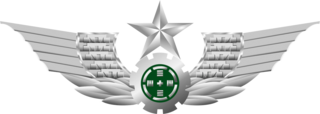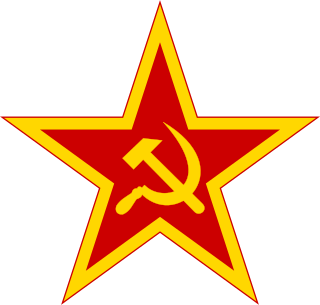Strategic rocket forces may refer to:

The Katyusha is a type of rocket artillery first built and fielded by the Soviet Union in World War II. Multiple rocket launchers such as these deliver explosives to a target area more intensively than conventional artillery, but with lower accuracy and requiring a longer time to reload. They are fragile compared to artillery guns, but are cheap, easy to produce, and usable on almost any chassis. The Katyushas of World War II, the first self-propelled artillery mass-produced by the Soviet Union, were usually mounted on ordinary trucks. This mobility gave the Katyusha, and other self-propelled artillery, another advantage: being able to deliver a large blow all at once, and then move before being located and attacked with counter-battery fire.

The Korean People's Army is the military force of North Korea and the armed wing of the Workers' Party of Korea (WPK). The KPA consists of five branches: the Ground Force, the Naval Force, the Air and Anti-Air Force, the Missile General Bureau, and the Special Operation Force. It is commanded by the WPK Central Military Commission, which is chaired by the WPK general secretary, and the president of the State Affairs; both posts are currently headed by Kim Jong Un.
A division is a large military unit or formation, usually consisting of between 6,000 and 25,000 soldiers. In most armies, a division is composed of several regiments or brigades; in turn, several divisions typically make up a corps.

In military tactics, close air support (CAS) is defined as aerial warfare actions—often air-to-ground actions such as strafes or airstrikes—by military aircraft against hostile targets in close proximity to friendly forces. A form of fire support, CAS requires detailed integration of each air mission with fire and movement of all forces involved. CAS may be conducted using aerial bombs, glide bombs, missiles, rockets, autocannons, machine guns, and even directed-energy weapons such as lasers.

The People's Liberation Army Ground Force is the land-based service branch of the People's Liberation Army and the largest and oldest branch of the entire Chinese armed forces. The PLAGF can trace its lineage from 1927 as the Chinese Red Army; however, it was not officially established until 1948.

The Republic of Korea Marine Corps, also known as the ROK Marine Corps, ROK Marines or South Korean Marine Corps, is the naval infantry of South Korea. The ROKMC is a branch of the Republic of Korea Navy responsible for amphibious operations, and also functions as a rapid reaction force and a strategic reserve.

The Battle of Osan was the first engagement between the United States and North Korea during the Korean War. On July 5, 1950, Task Force Smith, an American task force of 540 infantry supported by an artillery battery, was moved to Osan, south of Seoul, the capital of South Korea, and was ordered to fight as a rearguard to delay the advancing North Korean forces while more US troops arrived to form a stronger defensive line to the south. The task force lacked both anti-tank guns and effective infantry anti-tank weapons and had been equipped with obsolete 2.36-inch rocket launchers and a few 57 mm recoilless rifles. Aside from a limited number of HEAT shells for the unit's 105 mm howitzers, crew-served weapons that could defeat T-34/85 tanks from the Soviet Union had not yet been distributed to the US Army forces in South Korea.

The People's Liberation Army Rocket Force, formerly the Second Artillery Corps, is the strategic and tactical missile force of the People's Republic of China. The PLARF is the 4th branch of the People's Liberation Army (PLA) and controls China's arsenal of land-based ballistic missiles—both nuclear and conventional. The armed service branch was established on 1 July 1966 and made its first public appearance on 1 October 1984. The headquarters for operations is located at Qinghe, Beijing. The PLARF is under the direct command of the Chinese Communist Party's Central Military Commission (CMC).

The Fajr-3 is an Iranian heavy 240 mm intermediate-range multiple-launch artillery rocket (MLRS). The Fajr-3 is a license-built copy, with slight modifications, of a North Korean MLRS called the M-1985. The Fajr-3 was introduced in the 1990s and has since been exported to Hamas and Hezbollah.

The Korean People's Army Ground Force is the main branch of the Korean People's Army, responsible for land-based military operations.

The Soviet Army or Soviet Ground Forces was the main land warfare uniform service branch of the Soviet Armed Forces from 1946 to 1992.
The national security of China is the coordination of a variety of organizations, including law enforcement, military, paramilitary, governmental, and intelligence agencies that aim to ensure China's national security. China considers three factors in its national security: national sovereignty, security, and development interests.

The Korean People's Army Strategic Force, previously known as the Korean People's Army Strategic Rocket Force and as the Missile Guidance Bureau, is a military branch of the Korean People's Army that oversees North Korea's nuclear and conventional strategic missiles. It is mainly armed with surface-to-surface missiles of domestic design as well as older Soviet and Chinese models. The KPA Strategic Force was established in 1999 when several missile units under KPA Ground Force Artillery Command were re-organized into a single missile force reporting directly to the office of the Supreme Commander of the KPA via the General Staff.

The 35th Red Banner Orders of Kutuzov and Aleksandr Nevsky Rocket Division is a strategic missile division of the Strategic Rocket Forces of Russia. Part of the 33rd Guards Rocket Army, the division is based in the closed settlement (ZATO) of Sibirsky, near Barnaul, Altai Krai.

The Type 63 multiple rocket launcher is a towed, 12-tube, 107mm rocket launcher produced by the People's Republic of China in the early 1960s and later exported and manufactured globally. Although no longer serving with active infantry units, the Type 63 is still in People's Liberation Army service with specialized formations such as mountain infantry units and special forces detachments. The Type 63 was widely used in the PLA until the late 1980s. It was adopted as the successor of the Type 50-5 of 102mm.

A space force is a military branch of a nation's armed forces that conducts military operations in outer space and space warfare. The world's first space force was the Russian Space Forces, established in 1992 as an independent military service. However, it lost its independence twice, first being absorbed into the Strategic Rocket Forces from 1997 to 2001 and again in 2015, when it was merged with the Russian Air Force to form the Russian Aerospace Forces, where it now exists as a sub-branch. As of 2023 the world's only independent space forces are the United States Space Force and China's People's Liberation Army Strategic Support Force, which also is China's cyber force.
Lt. Gen. Kim Rak-gyom is the former head of North Korea's Strategic Rocket Forces.
The KN-09 (K-SS-X-9) is a North Korean 300 mm rocket artillery system of a launcher unit comprising eight rockets packaged in two four-rocket pods.
Li Xianyu is a Chinese engineer and missile expert. She serves as the director of a research institute of the People's Liberation Army Rocket Force Research Academy and holds the military rank of major general. She is an academician of the Chinese Academy of Engineering.